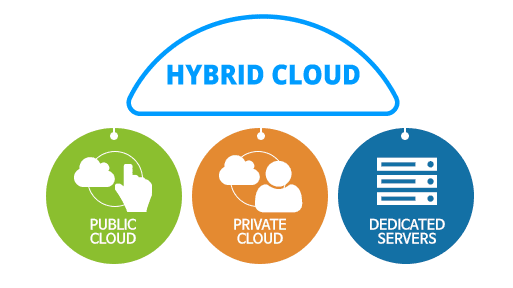Top Three Strategic Reasons Why Hybrid Cloud is the Pragmatic Choice

Top Three Strategic Reasons Why Hybrid Cloud is the Pragmatic Choice
Businesses are adopting cloud technologies at an unprecedented speed, transforming how they handle communications, applications, backups, and compute. Yet, despite the market drive toward "all-in" cloud solutions, the reality for most B2B organizations is a balanced, measured approach.
The vast majority of companies today operate with a hybrid infrastructure: they use the public cloud for certain applications, a private cloud for others, while retaining physical or colocation infrastructure for specialized or legacy workloads.
This is not a sign of hesitation; it is a sign of pragmatism. A custom-fit hybrid approach is often the most strategic way to ensure resources across the entire enterprise are supported fully, ensuring optimal performance and maximum cost efficiency.
Here are the top three strategic reasons businesses are consciously choosing the hybrid route.
1. Increase Flexibility and Regulatory Agility
The core benefit of hybrid cloud lies in its unparalleled flexibility—it combines the best attributes of different environments to meet diverse and often conflicting needs. A single architecture cannot successfully satisfy all requirements across a large enterprise, which may include regulatory demands, multiple complex applications, varying data storage needs, and aggressive development cycles.
Beyond the Single Platform Trap
A critical mistake in cloud strategy is adhering to a one-size-fits-all model. Hybrid cloud allows an organization to place each application or workload on the platform best suited for it.
Application Placement: Mission-critical systems requiring dedicated resources, predictable latency, or the power of bare metal can reside in a Private Cloud or dedicated Colocation. Meanwhile, highly scalable or variable workloads—like development, testing, and seasonal e-commerce traffic—can burst into the Public Cloud, leveraging its on-demand resources without over-provisioning private infrastructure. This flexibility is key to meeting fluctuating business demands without massive, unpredictable capital outlay.
The Power of Policy-Driven Placement: True hybrid flexibility is less about where the resource is and more about the policy that dictates its location. By establishing clear policies based on criteria like data sensitivity, performance requirements, and cost-per-hour, B2B leaders can build an infrastructure that dynamically optimizes itself. This requires a vendor-neutral, overarching strategy that treats all infrastructure—public, private, and on-premise—as a single resource pool.
Navigating Compliance and Data Sovereignty
For industries like finance (FINRA, PCI), healthcare (HIPAA), or government, strict data sovereignty and compliance rules often preclude using a multi-tenant public cloud for certain sensitive data sets. A hybrid strategy ensures compliance by creating necessary walls of isolation.
Regulatory Isolation: A dedicated Private Cloud environment or secure Colocation facility can host data that must remain within strict geographic or regulatory boundaries. The private element of the hybrid system acts as a high-security vault, ensuring compliance by restricting access to a single organization.
Accessing Agility Without Compromise: This doesn't mean sacrificing the agility of the public cloud. The hybrid model allows the processing of non-sensitive data, development environments, and front-end user applications to utilize public cloud resources, while the sensitive, regulated data store remains secure in the private environment. This balanced approach provides regulatory peace of mind without creating a development bottleneck.
Strategic Staggered Migration
For organizations with existing physical infrastructure, a hybrid approach allows them to stagger their migration. They can immediately leverage cloud benefits for low-hanging fruit (like disaster recovery or collaboration tools) while methodically planning the virtualization of complex legacy systems. This achieves consolidation goals on the company’s terms, not a vendor’s rushed deadline. The ability to use existing hardware until its natural end-of-life significantly reduces premature asset write-offs and ensures a more financially sound transition.
2. Reduce Costs Through Strategic Optimization
The assumption that "cloud is always cheaper" has been proven false for many businesses. Hybrid cloud allows businesses to realize genuine cost savings by providing intelligent controls over the most expensive aspect of public cloud consumption: data egress fees, and by optimizing resource allocation.
The Egress Fee Burden and Mitigation
Data egress is the cost charged by hyperscale providers (AWS, Azure, GCP) to move data out of their cloud environment. For businesses engaging in data analytics, replication for disaster recovery, or moving data between clouds, these fees can quickly accumulate, turning what seemed like a cost-saving strategy into a budgetary liability.
Mitigating Egress Fees is Crucial: This is arguably the most financially compelling reason for a hybrid approach. By positioning a dedicated hybrid cloud aggregator or using a smart interconnection strategy, businesses can significantly reduce the connectivity needed directly to hyperscale providers. By processing data closer to its destination or using proprietary private connections, this strategic placement can result in cutting AWS, Azure, GCP, and IBM egress fees by up to 66%—a massive, immediate saving for any data-intensive organization.
Avoiding Repurchase Costs (The Retain Strategy): As discussed in the "6 R's" migration strategy, some applications should simply be retained. A hybrid strategy validates this decision. By keeping certain legacy, low-changing applications on existing or managed dedicated infrastructure, the business avoids the massive cost of rewriting (Refactoring) or porting (Rehosting) them to a hyperscale environment where the cost of operation might exceed the cost of maintenance.
Strategic Financial Discipline: OpEx vs. CapEx
Hybrid architecture promotes financial discipline by ensuring resources are always optimized and aligned with the OpEx model.
Right-Sizing the Environment: You limit data transfer fees, control resource and storage costs precisely, and avoid the public cloud trap of over-provisioning resources just to be safe. By paying for precisely what is used, and nothing more, you maximize every infrastructure investment.
Predictable Operational Expenditure (OpEx): While Public Cloud is consumption-based, Private Cloud components of a hybrid environment often operate on a subscription-based OpEx model. This combines the budget predictability required by finance departments with the agility needed by IT, allowing for easier, more reliable quarterly and annual forecasting than relying purely on volatile, consumption-based public cloud metrics.
3. Improve Efficiency and Align Resources with Strategy
For many companies, highly skilled and highly compensated IT professionals are spending an excessive amount of time on the care and feeding of physical infrastructure—tasks that do not advance the core business mission. This is the definition of IT fatigue, and it directly impacts a company's ability to innovate.
Freeing IT to Focus on Business Value
Migrating appropriate workloads to a hosted datacenter or cloud environment helps to strategically free those resources, allowing them to shift their focus to helping advance strategic business initiatives.
Focus on Innovation: When the infrastructure is managed, maintained, and scaled by the cloud provider, the internal IT team is freed to focus on application optimization, security strategy, and business intelligence. They stop reacting to server alerts and start contributing to growth, competitive advantage, and business-facing projects. This directly translates infrastructure efficiency into business value.
The TCO of IT Fatigue: The Total Cost of Ownership (TCO) calculation for on-premise hardware often fails to account for the true cost of time spent by highly paid engineers on maintenance tasks like patching, cooling, and power management. Shifting these tasks to a hybrid provider dramatically reduces this shadow cost.
Elastic Adaptability and Future-Proofing
The hybrid model ensures the infrastructure solution is fluid and adaptable, essential in a rapidly changing B2B environment.
Dynamic Workload Shifting: A flexible, scalable hybrid infrastructure solution ensures that as workloads shift (due to consolidation, acquisition, or a new product launch), the underlying infrastructure adapts dynamically. The business avoids being locked into static, rigid systems.
Optimal Resource Placement: The ultimate efficiency gain is tailoring your infrastructure so that every application or workload is supported by the platform best suited for it, rather than forcing a one-size-fits-all approach. This keeps the business on target to reach its goals by prioritizing performance and financial governance simultaneously. Furthermore, a hybrid approach allows a business to strategically use emerging technologies—such as edge computing or serverless functions—wherever they make the most sense, integrating them seamlessly with existing private core systems.
Finding the Right Mix in a Complex Landscape
Adopting a hybrid strategy is the smart move, but executing it flawlessly requires navigating a diverse and often confusing landscape of cloud aggregators, interconnection providers, colocation facilities, private cloud managers, and managed services firms.
The right hybrid approach isn't something you buy off the shelf; it's a strategic architecture you build to meet your specific needs. That complexity—the sheer number of vendors, contracts, and technical specifications—is precisely where impartial, vendor-neutral expertise becomes invaluable.
We partner only with our clients, operating solely as an expert resource to find the perfect mix of solutions and the best providers to deliver them. Our only objective is to ensure we are bringing the right companies from our Supplier Portfolio to help you achieve your goals and objectives.
Technology. Driven. Outcomes.
Next Step
If you are currently evaluating how to combine your existing infrastructure with modern cloud services to gain better financial and operational control, the next step is to formalize your hybrid strategy, making specific decisions about application placement and vendor selection.
If you are ready to identify and evaluate the portfolio of companies needed to establish the most effective custom-fit hybrid approach for your business, get in touch to explore your options.

